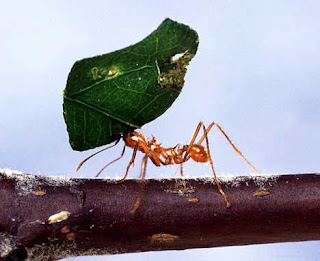I did a bit of research and came up with the following information.
The reason that ants can lift (and pull) so much is apparently due to a matter of scale. I expect it also helps them having several legs, in terms of traction, but this is not mentioned in the stuff that I found. Apparently ant muscles are no stronger than human muscles on a pull-for-pull basis, but the small size of ants gives them an advantage on how much muscle force they can produce.
A muscle is basically a bundle of fibres which can contract and create a pulling force. The amount of force produced by any muscle is proportional to the cross sectional area of that bundle of fibres. Consider a bundle of bungee cords: one bungee cord has a small cross sectional area and doesn't exert much force (you wouldn't jump off a bridge with just one bungee cord to stop you!); a bundle of bungee cords, such as is used for jumping, has a much greater cross sectional area, and exerts much more force (enough force to stop a bungee jumper from hitting the ground!). In human terms, you can think of a bicep muscle: the bigger the bicep, the larger the cross-sectional area, and the more force that can be applied by that bicep. The strength of insect and vertebrate muscles, in terms of force per square centimetre, are identical.
The reason that ants can lift so much is because body size (in terms of volume, which is closely related to mass) increases as a cube of length, while the cross sectional area of muscles increases as the square of length. This is known as the "square/cube" rule. Hence, as the size of an organism increases, its mass increases at a much greater rate than the cross-sectional area of its muscles, so those muscles have proportionately more mass to lift just to make the body fonction. The small size of an ant means that it doesn't have a large body mass to carry around, but it has proportionately more muscle (in terms of that cross-sectional area) that can be used to lift heavy things. Conversely, humans are proportionately more massive, and thus have less muscle that is avaialble for other tasks, such as lifting heavy things. One could even extrapolate to surmise that If humans were the size of ants, they would be able to lift objects as heavy (or even more).
But there is another factor in what I observed that makes me curious, and that is the sheer persistence of this animal and its sense of purpose. Well, maybe another time....


What Virgin Mary can do for you .....
ReplyDeleteBerthomeau’s post of the day is as puzzling as yours.
Does your reasoning also apply to a penis, though it’s not a matter of muscle there?
I’m trying to lift a fly ... or at least open it.
I know nothing of the Virgin Mary (especially from the biblical point of view) and even less of ants' penis. Do they have them?
ReplyDeleteBungee cords are incredibly versatile, durable, and perfect for securing items quickly and safely during travel.
ReplyDeleteBungee Cords